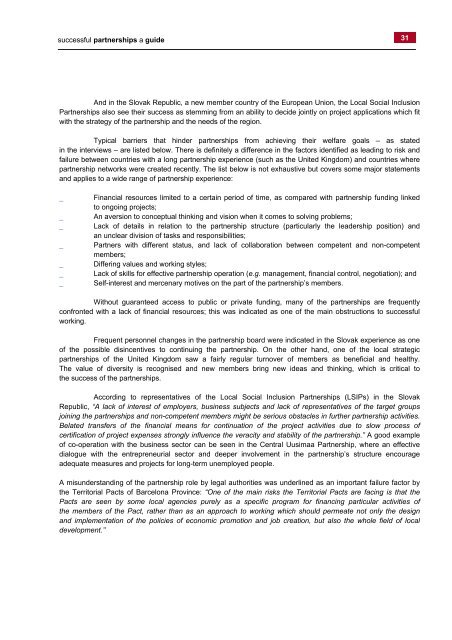successful partnerships a guide - Organisation for Economic Co ...
successful partnerships a guide - Organisation for Economic Co ...
successful partnerships a guide - Organisation for Economic Co ...
You also want an ePaper? Increase the reach of your titles
YUMPU automatically turns print PDFs into web optimized ePapers that Google loves.
<strong>successful</strong> <strong>partnerships</strong> a <strong>guide</strong><br />
31<br />
And in the Slovak Republic, a new member country of the European Union, the Local Social Inclusion<br />
Partnerships also see their success as stemming from an ability to decide jointly on project applications which fit<br />
with the strategy of the partnership and the needs of the region.<br />
Typical barriers that hinder <strong>partnerships</strong> from achieving their welfare goals – as stated<br />
in the interviews – are listed below. There is definitely a difference in the factors identified as leading to risk and<br />
failure between countries with a long partnership experience (such as the United Kingdom) and countries where<br />
partnership networks were created recently. The list below is not exhaustive but covers some major statements<br />
and applies to a wide range of partnership experience:<br />
_<br />
_<br />
_<br />
_<br />
_<br />
_<br />
_<br />
Financial resources limited to a certain period of time, as compared with partnership funding linked<br />
to ongoing projects;<br />
An aversion to conceptual thinking and vision when it comes to solving problems;<br />
Lack of details in relation to the partnership structure (particularly the leadership position) and<br />
an unclear division of tasks and responsibilities;<br />
Partners with different status, and lack of collaboration between competent and non-competent<br />
members;<br />
Differing values and working styles;<br />
Lack of skills <strong>for</strong> effective partnership operation (e.g. management, financial control, negotiation); and<br />
Self-interest and mercenary motives on the part of the partnership’s members.<br />
Without guaranteed access to public or private funding, many of the <strong>partnerships</strong> are frequently<br />
confronted with a lack of financial resources; this was indicated as one of the main obstructions to <strong>successful</strong><br />
working.<br />
Frequent personnel changes in the partnership board were indicated in the Slovak experience as one<br />
of the possible disincentives to continuing the partnership. On the other hand, one of the local strategic<br />
<strong>partnerships</strong> of the United Kingdom saw a fairly regular turnover of members as beneficial and healthy.<br />
The value of diversity is recognised and new members bring new ideas and thinking, which is critical to<br />
the success of the <strong>partnerships</strong>.<br />
According to representatives of the Local Social Inclusion Partnerships (LSIPs) in the Slovak<br />
Republic, “A lack of interest of employers, business subjects and lack of representatives of the target groups<br />
joining the <strong>partnerships</strong> and non-competent members might be serious obstacles in further partnership activities.<br />
Belated transfers of the financial means <strong>for</strong> continuation of the project activities due to slow process of<br />
certification of project expenses strongly influence the veracity and stability of the partnership.” A good example<br />
of co-operation with the business sector can be seen in the Central Uusimaa Partnership, where an effective<br />
dialogue with the entrepreneurial sector and deeper involvement in the partnership’s structure encourage<br />
adequate measures and projects <strong>for</strong> long-term unemployed people.<br />
A misunderstanding of the partnership role by legal authorities was underlined as an important failure factor by<br />
the Territorial Pacts of Barcelona Province: “One of the main risks the Territorial Pacts are facing is that the<br />
Pacts are seen by some local agencies purely as a specific program <strong>for</strong> financing particular activities of<br />
the members of the Pact, rather than as an approach to working which should permeate not only the design<br />
and implementation of the policies of economic promotion and job creation, but also the whole field of local<br />
development.’’








